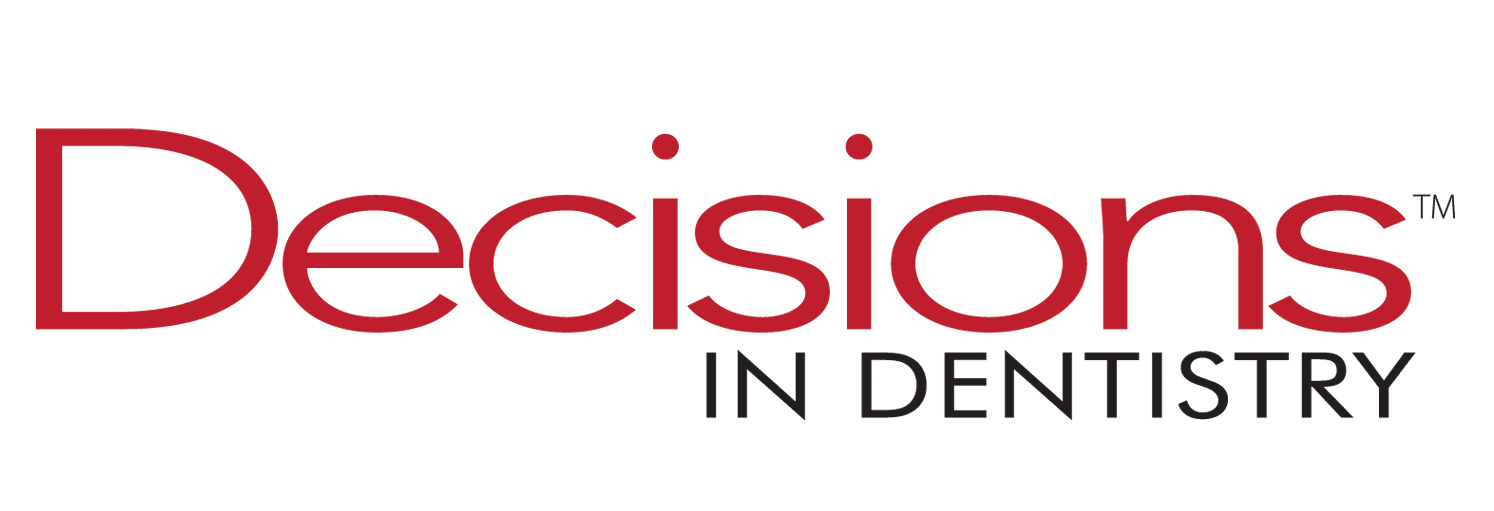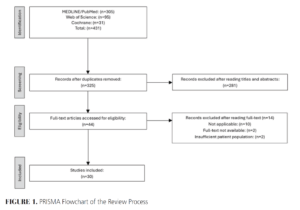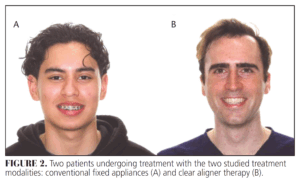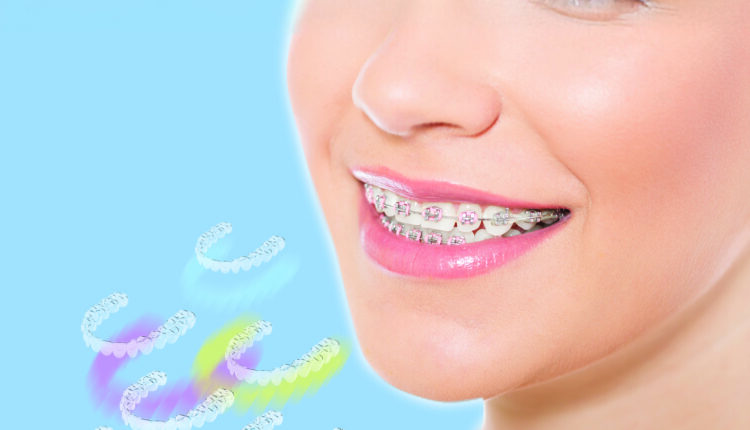
Patient Satisfaction in Clear Aligner Therapy and Fixed Appliances
While patient satisfaction appears similar across both treatments, clear aligners offer advantages in comfort, esthetics, and eating, though fixed appliances remain more effective for complex cases.
A deeper understanding of patient satisfaction in today’s landscape can help the clinician guide treatment planning, build a patient base and referral network, and, ultimately, deliver better care that suits each patient’s needs.1 In healthcare, the patient’s satisfaction is determined by the human experience and the treatment outcome.2 However, orthodontic care has specific criteria, including pain during treatment, esthetics during and post-treatment, duration of treatment, and occlusion after treatment.
Even though clear aligner therapy (CAT) is more effective at the segmented movement of teeth and presents shorter treatment durations, traditional brackets provide significant improvements in retention, occlusal contacts, torque control, and transverse management.5 However, other factors, such as patient preference, likely contribute to CAT’s popularity considering its rising demand.
Available data regarding patient satisfaction between these two treatment modalities remains sparse and disjointed. A consolidated examination of the existing literature should provide orthodontists with a more nuanced view of the variation in satisfaction between the treatments.
The aim of this study is to assess current evidence surrounding patient satisfaction, determine whether a difference exists between levels of satisfaction after completing CAT and fixed appliances, and explore the potential factors that contribute to any discrepancies found.
Materials and Methods
The search method was determined using the PICO method for each subsection. The population (orthodontic patients), intervention (CAT), and comparison (fixed appliances) stayed the same throughout the paper. The outcome changed for each subsection: patient satisfaction, pain, duration of treatment, eating, esthetics, and speech.
A comprehensive electronic search was conducted in January 2023 to identify relevant works published through December 2022. PubMed, Cochrane, and Web of Science databases were used. Articles found were initially screened by title and abstract. They were confirmed to align with inclusion/exclusion criteria. After the initial screening, a full-text review was completed, and inclusion was decided upon. Systematic reviews, meta-analyses, and peer-reviewed original papers in English were included. Articles that did not include clinical studies, single case reviews, or case series with fewer than 10 patients were excluded.
Results
During the literature review, 431 references were identified. The original pool was screened by reviewing titles and abstracts, which resulted in 44 references for full-text evaluation and 30 papers were included in the final analysis (Figure 1).
- Patient satisfaction. Four studies6-9 directly compared patient satisfaction between fixed appliance therapy and CAT (Figure 2). Alfawal et al6 indicated higher satisfaction for CAT than the group with traditional brackets. However, Alajmi et al,7 Flores-Mir et al,8 and Sharma et al9 reported that both treatment groups were generally very satisfied with their treatment.
- Quality of life. Ten studies6–8,10–14 were identified for quality-of-life indicators. Quality of life before and after orthodontic treatment improved regardless of treatment modality.6 Three studies reported more significant improvement with clear aligners.6,10,13 Four studies13,15–17 noted no difference in post-treatment quality of life while indicating more negative impacts during treatment for fixed appliances. In addition, Flores-Mir et al8 identified significant differences in eating and chewing evaluations with 47% of CAT patients compared to 24% of the fixed appliance group completely satisfied in this dimension.
- Perception of pain. Eight studies directly compared pain perception between the two modalities with dental impacts on daily living survey8 and the visual analog scale.6,7,10,11,18–20 A significant difference between pain levels was reported in six studies with conventional fixed therapy inducing more pain during the first week.6,10,11,18–20 In addition, CAT was correlated with less analgesic use.7,11,20 While Alajmi et al7 found no significant difference for pain, they confirmed the increased use of analgesics with conventional braces.
- Duration of Treatment. Many studies compared the differences in treatment length between precise aligner therapy and conventional fixed appliances.5,21–28 Controlling the severity of malocclusion or case complexity, most reports identified less treatment time for clear aligners.5,21,23-26,28 Zheng et al26 added more efficient chair time for apparent aligner efficiency. While an average of 4 months shorter treatment time was reported for CAT in crowding resolution,24,25 Buschang et al29 argued that fixed appliances resulted in a 67% longer treatment time than clear aligners in cases presenting with < 5 mm crowding.
However, a systematic review investigating the efficacy and efficiency of clear aligners in more complex cases, including bicuspid extractions, showed that conventional fixed appliances treated patients more efficiently, concluding that fixed appliances achieve better buccolingual inclination and occlusal contacts in a shorter duration.22
- Eating. Significant differences existed when evaluating eating between CAT and fixed appliances.4,6–10,20,30 Generally, clear aligner patients expressed higher satisfaction, more comfort when chewing food, a more satisfactory diet, fewer interrupted meals, and less food impaction.6,8,9,10,20
- Esthetics. Esthetics was a significant determinant for seeking treatment with clear aligners compared to fixed appliances.7,8,30 However, variation existed between the studies. Alajmi et al7 reported more satisfaction with the appearance of CAT than fixed appliance patients, but the difference was insignificant. Flores-Mir et al8 reported no difference between the two treatment modalities regarding satisfaction with appearance after the treatment.
Gao et al10 found that anxiety levels were lower in patients with CAT and extrapolated that the esthetic features of aligners could be pivotal in reducing anxiety levels. Alfawal et al6 demonstrated that CAT patients reported significantly lower oral health impact profile scores than the fixed appliance patients, which was attributed to the esthetic nature of the clear aligners.
- Speech. A recent study evaluated speech using three different methods free of bias and found that both clear aligner and fixed appliance treatments significantly impacted speech.31 However, more change was found in clear aligner patients. The most significant finding from the study was that speech function returned to baseline within 2 months of having fixed appliances placed. In contrast, with a clear aligner, speech was still significantly affected 2 months after starting the treatment. Alajmi et al7 reported similar findings.
Damasceno et al32 reported a marked change in speech production with aligners at time zero and 3 days after insertion. However, no difference in speech or perceived impairment was recorded after the initial time points. Contrary to the three studies cited,7,31,32 less disruption in daily life due to speech disturbances was also reported.10
Discussion
Esthetics is the driving force behind why patients choose clear aligners over fixed appliances.7,8,30 While there was minimal difference in satisfaction between CAT and fixed appliance post-treatment,7,8 CAT induced less psychological discomfort and lower anxiety levels during treatment.6,10 Although CAT may not successfully complete specific movements, CAT showed a significantly shorter treatment duration than braces,5 even when the studies were controlled for their severity.6,24,26 However, when treating more complex patients, conventional fixed appliances are still regarded as the more efficient option.22
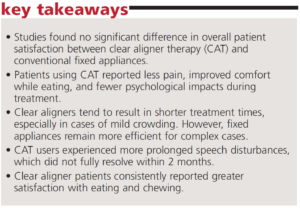 Most of the studies6,10,11,18-20 included in the review reported less pain for patients treated with CAT compared to patients treated with conventional fixed appliances. In addition, analgesic use was higher in patients with conventional fixed appliances.7,11 This could be due to several reasons: patients were in less pain with CAT or expected to be in less pain with CAT. Because clear aligners can be removed, there is little to no impact reported with eating during treatment.6,10 In contrast, patients with fixed appliances experienced a range of difficulties with eating, from a brief adjustment period to ongoing discomfort while chewing throughout treatment.8
Most of the studies6,10,11,18-20 included in the review reported less pain for patients treated with CAT compared to patients treated with conventional fixed appliances. In addition, analgesic use was higher in patients with conventional fixed appliances.7,11 This could be due to several reasons: patients were in less pain with CAT or expected to be in less pain with CAT. Because clear aligners can be removed, there is little to no impact reported with eating during treatment.6,10 In contrast, patients with fixed appliances experienced a range of difficulties with eating, from a brief adjustment period to ongoing discomfort while chewing throughout treatment.8
CAT patients had more of a “lisp” that did not improve over time wearing the trays.31 Although patients with fixed appliances also had their speech impacted, they adapted to the appliances over time. This could be due to the patient’s disposition to adapt to the permanent appliances.7,31 A correlation between CAT wear time and the effect on speech has not been studied but would be an exciting avenue of research.
Within the available evidence no significant difference in overall patient satisfaction between CAT and conventional fixed appliances was identified.
References
- Donabedian A. Quality assurance in health care: consumers’ role. Qual Health Care. 1992;1:247-251.
- Ng JHY, Luk BHK. Patient satisfaction: Concept analysis in the healthcare context.Patient Educ Couns. 2019;102:790-796.
- Lee R, Hwang S, Lim H, Cha JY, Kim KH, Chung CJ. Treatment satisfaction and its influencing factors among adult orthodontic patients. Am J Orthod Dentofacial Orthop. 2018;153:808-817.
- Pacheco-Pereira C, Brandelli J, Flores-Mir C. Patient satisfaction and quality of life changes after Invisalign treatment. Am J Orthod Dentofacial Orthop. 2018;153:834-841.
- Ke Y, Zhu Y, Zhu M. A comparison of treatment effectiveness between clear aligner and fixed appliance therapies. BMC Oral Health.2019;19:24.
- Alfawal AMH, Burhan AS, Mahmoud G, Ajaj MA, Nawaya FR, Hanafi I. The impact of non-extraction orthodontic treatment on oral health-related quality of life: clear aligners versus fixed appliances — a randomized controlled trial. Eur J Orthod. 2022;44:595-602.
- Alajmi S, Shaban A, Al-Azemi R. Comparison of short-term oral impacts experienced by patients treated with invisalign or conventional fixed orthodontic appliances. Med Princ Pract.2020;29:382-388.
- Flores-Mir C, Brandelli J, Pacheco-Pereira C. Patient satisfaction and quality of life status after 2 treatment modalities: Invisalign and conventional fixed appliances. Am J Orthod Dentofacial Orthop. 2018;154639-644.
- Sharma R, Drummond R, Wiltshire W, et al. Quality of life in an adolescent orthodontic population. Angle Orthod. 2021;91:718-724.
- Gao M, Yan X, Zhao R, et al. Comparison of pain perception, anxiety, and impacts on oral health-related quality of life between patients receiving clear aligners and fixed appliances during the initial stage of orthodontic treatment. Eur J Orthod.2021;43:353-359.
- Almasoud NN. Pain perception among patients treated with passive self-ligating fixed appliances and Invisalign® aligners during the first week of orthodontic treatment. Korean J Orthod. 2018;48:326.
- White DW, Julien KC, Jacob H, Campbell PM, Buschang PH. Discomfort associated with Invisalign and traditional brackets: A randomized, prospective trial. Angle Orthod.2017;87:801-808.
- Azaripour A, Weusmann J, Mahmoodi B, et al. Braces versus Invisalign®: gingival parameters and patients’ satisfaction during treatment: a cross-sectional study. BMC Oral Health.2015;15(1):69.
- Jaber ST, Hajeer MY, Burhan AS, Latifeh Y. The effect of treatment with clear aligners versus fixed appliances on oral health-related quality of life in patients with severe crowding: a one-year follow-up randomized controlled clinical trial. Cureus.2022;14:e25472.
- Miller KB, McGorray SP, Womack R, et al. A comparison of treatment impacts between Invisalign aligner and fixed appliance therapy during the first week of treatment. Am J Orthod Dentofacial Orthop. 2007;131:302.e1-302.e9.
- Zamora-Martínez N, Paredes-Gallardo V, García-Sanz V, Gandía-Franco JL, Tarazona-Álvarez B. Comparative study of oral health-related quality of life (OHRQL) between different types of orthodontic treatment. Med Kaunas Lith.2021;57:7.
- Paes da Silva S, Pitchika V, Baumert U, et al. Oral health-related quality of life in orthodontics: a cross-sectional multicentre study on patients in orthodontic treatment. Eur J Orthod. 2020;42:270-280.
- Fujiyama K, Honjo T, Suzuki M, Matsuoka S, Deguchi T. Analysis of pain level in cases treated with Invisalign aligner: comparison with fixed edgewise appliance therapy. Prog Orthod. 2014;15:64. 19. Diddige R, Negi G, Kiran K, Chitra P. Comparison of pain levels in patients treated with 3 different orthodontic appliances – a randomized trial. Med Pharm Rep. 2020;93:81-88.
- Baseer MA, Almayah NA, Alqahtani KM, Alshaye MI, Aldhahri MM. Oral impacts experienced by orthodontic patients undergoing fixed or removable appliances therapy in Saudi Arabia: A cross-sectional study. PATIENT Prefer ADHERENCE. 2021;15:2683-2691.
- Doomen RA. Possibilities and limitations of treatment with clear aligners. An orientation. Ned Tijdschr Tandheelkd.2018;125(:533-540.
- Jaber ST, Hajeer MY, Sultan K. Treatment effectiveness of clear aligners in correcting complicated and severe malocclusion cases compared to fixed orthodontic appliances: a systematic review. CUREUS J Med Sci. 2023;15:4.
- Alford TJ, Roberts WE, Hartsfield JK, Eckert GJ, Snyder RJ. Clinical outcomes for patients finished with the SureSmileTM method compared with conventional fixed orthodontic therapy. Angle Orthod. 2011;81:383-388.
- Lanteri, Valentina, Farronato, Giampietro, Lanteri, Claudio, Caravita, Rosanna, Cossellu, Gianguido. The efficacy of orthodontic treatments for anterior crowding with Invisalign compared with fixed appliances using the Peer Assessment Rating Index. Quintessence Int. 2018;49:581-587.
- Djeu G, Shelton C, Maganzini A. Outcome assessment of Invisalign and traditional orthodontic treatment compared with the American Board of Orthodontics objective grading system. Am J Orthod Dentofacial Orthop. 2005;128:292-298.
- Zheng M, Liu R, Ni Z, Yu Z. Efficiency, effectiveness and treatment stability of clear aligners: A systematic review and meta-analysis. Orthod Craniofac Res. 2017;20:127-133.
- Papageorgiou SN, Koletsi D, Iliadi A, Peltomaki T, Eliades T. Treatment outcome with orthodontic aligners and fixed appliances: a systematic review with meta-analyses. Eur J Orthod. 2020;42:331-343.
- Yassir YA, Nabbat SA, McIntyre GT, Bearn DR. Clinical effectiveness of clear aligner treatment compared to fixed appliance treatment: an overview of systematic reviews. Clin ORAL Investig. 2022;26:2353-2370.
- Buschang PH, Shaw SG, Ross M, Crosby D, Campbell PM. Comparative time efficiency of aligner therapy and conventional edgewise braces. Angle Orthod. 2014;84:391-396.
- Alami S, Sahim S, Hilal F, Essamlali A, Quars FE. Perception and satisfaction of patients treated with orthodontic clear aligners.OALib.2022;09:1-11.
- Fraundorf EC, Araújo E, Ueno H, Schneider PP, Kim KB. Speech performance in adult patients undergoing Invisalign treatment. Angle Orthod. 2022;92:80-86.
- Damasceno Melo PE, Bocato JR, de Castro Ferreira Conti AC, et al. Effects of orthodontic treatment with aligners and fixed appliances on speech: A randomized clinical trial. ANGLE Orthod. 2021;91:711-717.
From Decisions in Dentistry. July/August 2025;11(4):9-13.
